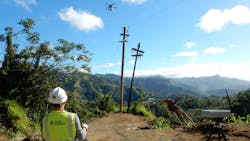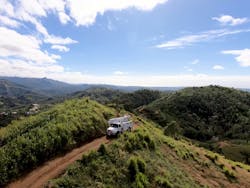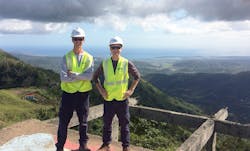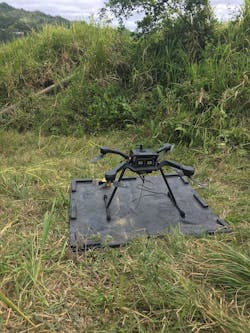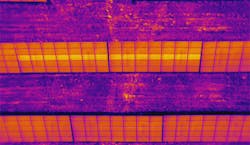How Duke Energy Used Drones to Restore Power in Puerto Rico
Hurricane Maria left Puerto Rico’s electric grid in pieces when it blew through the island in October 2017. The 155-mph, Category 4 storm knocked out power for 1.5 million people causing the largest blackout in American history and the second largest in the world. For nearly a year after the storm, workers from several utilities – including more than 220 from Duke Energy – scoured the island for broken poles and downed power lines that, in some places, were buried under months of overgrown vegetation to restore power to every person.
It was a challenging terrain – remote, with stark mountains and thick jungles – but lineworkers worked 16-hour days climbing through it to restore power. However, Duke Energy had a way to improve the process.
To help the crews find the buried infrastructure, Rufus Jackson, Duke Energy vice president of distribution, construction and maintenance, summoned the company’s drone team. He knew they would be able to fly drones above mountains and deep ravines to look for damage and uncover safe paths for crews to access structures, but he didn’t know they would be able to help restore power too.
Jacob Velky and Bryan Williams, from the Duke Energy Unmanned Aircraft System team, used a device they invented months earlier by their teammate Isaac Medford to pull a lead line and connect distribution poles.
“It made our jobs easier, more efficient, and a lot safer because now we don’t have to put humans in the ravines and gorges to try to find the old wire,” Jackson said. “Basically, we have the new pre-line hung up, and now we have something to connect to and finish the restoration.”
Duke Energy has been using drones since 2015 and is among many utilities that inspect solar panels, wind turbines, transmission lines, and other structures with infrared and high-zoom sensors, but Duke Energy is one of the first in the United States to use a drone to restring power lines.
They had the idea in 2017 when working on a transmission project in Indiana, where the only option for stringing the line was by helicopter – a hazardous but widely used method by trained experts in the utility industry.
During this construction process, a helicopter attaches what acts as a big needle to the end of a cable, flies up to the transmission tower, and hooks the cable on to one side. The helicopter disconnects from the cable, goes to the other side – all within 50 ft of the tower – and reconnects to the needle to pull it through the tower.
“A hazardous job is when the helicopter is clipping the line into the outside phases,” Velky said, “and it’s extremely hazardous when you’re stringing the center phase, which is right through the center of the tower.”
Dhiaa Jamil, Duke Energy executive vice president and chief operating officer, asked the team if it was possible to use a drone to pull a lighter weight string through the center of the tower to eliminate the helicopter task.
Velky said they hadn’t thought of that and a quick Google search didn’t show results of other utilities using the method either. He, Williams, and Medford went to work to figure out a way to make it happen.
After determining the distance between the two poles, they would use a 2.5-ft by 2.5-ft drone to carry a lightweight, nylon parachute cord. Medford then designed and 3D printed an electromagnet that allows them to drop the cord with precision. The magnet also provides a level of safety, so if the rope becomes tangled or the drone gets in a situation where they need to abort, they can drop that rope and bring the drone back safely.
They tested the process in Indiana and in a swampy area of North Carolina before going to Puerto Rico, where they strung 9000 ft of cord. The longest strand was 1200 ft – a little longer than three football fields. In 2019, the team won the company’s highest employee honor for their innovation – they also won the gratitude of their teammates in Puerto Rico for finding a safer and more efficient way to restore power.
In Puerto Rico, the alternate option for stringing the line over long distances, thick vegetation, or deep ravines, was shooting a brass projectile attached to a lightweight nylon cord from a shotgun. The method has worked well for years, but it has limitations in accuracy and distance. The maximum range for the gun is about 800 ft and many of the power poles in Puerto Rico are farther apart than that.
If the shooter misses, he or she must walk through the brush to find the projectile and try again.
As the team strung the first drone line in Puerto Rico, they were standing outside of a house that didn’t have power. Velky said it was a rewarding feeling when those people came outside to watch because he could see the faces of those they were helping.
“It was an awesome and impactful experience to get in the field and feel like you’re helping the customers,” Velky said. “This project is starting in the aviation services group, but on the horizon, we can see some groups in transmission and distribution (T&D) using this. I think this will continue to evolve.”
Here are four more ways Duke Energy is using drones:
For nearly a century, unmanned aerial vehicles – or drones – were primarily tools for the military, but in the last decade, the use of drones for civilian tasks has skyrocketed. Industries from real estate to agriculture and retail to entertainment are using the technology to work faster, safer, and in new ways.
The energy industry is no exception. Duke Energy started using drones in 2015 to inspect wind and solar sites and the technology’s use continues to grow in scope and complexity. The company’s drone team is housed at its hangar with the traditional aviation crew, which has helped the team establish safety procedures for a new technology based on decades of best practices from manned-aircraft pilots. The partnership has also increased efficiency by allowing the teams to easily determine which aircraft is the best for each job.
As drone capabilities continue to advance, the team is working with several departments on their strategy and ways to incorporate the technology from artificial intelligence to data storage. Here are four more ways Duke Energy is already using drones.
Examine equipment with thermal imaging
Flying a drone with an infrared camera over a solar site eliminates time-consuming electrical testing and helps technicians identify faulty equipment within seconds of takeoff.
Technicians have used handheld thermal imaging devices for years, but drones provide an overall view of the field in shades of purple to yellow, based on heat signatures. Hotter panels appear more yellow than surrounding panels. These bright spots indicate that the panels are not efficiently converting solar energy to electrical energy. A single yellow panel usually indicates a faulty panel that needs to be replaced. However, if a string of panels appears yellow, it’s probably an easily fixed electrical issue.
In addition to solar plants, drones can inspect power poles and substations with thermal imaging.
Attract new businesses
Drones can provide a unique perspective for businesses scouting locations. Keith Gabriel, who works with Duke Energy’s economic development team, became licensed to operate drones so he could help local governments highlight undeveloped land and attract new companies, jobs, and revenue to Duke Energy’s service area. They can fly a drone over the land in question to show prospective tenants a clearer view of the land’s potential, including characteristics like buildable area, nearby amenities, highways, and access roads.
Inspect towering equipment
Across the energy industry, drones are making it easier and safer to inspect many tall structures. Instead of climbing a power pole (some are more than 300 ft tall), using a bucket truck or helicopter, or standing at the bottom with a camera or binoculars, a drone can fly to the top and take pictures from multiple angles. Drones are also able to zoom in on equipment, which makes it easier to see small defects like cracks on a wind turbine or porcelain insulator.
In Ohio, a drone team inspected a transmission tower and right-of-way spanning the Ohio River. Jim Meyer, who worked on the project, said the drone did what could have taken days or weeks if lineworkers had to climb the 17 towers.
Duke Energy uses drones to inspect wind farms as well, which reduces the need for technicians to climb wind turbines and rappel down the blades.
Track construction
Drones can assist in construction from beginning to end. The Duke Energy team can use high-resolution photos and videos of a potential site to identify any sensitive areas like wetlands or produce 3D renderings that give engineers elevation data to determine things like how much dirt needs to be moved. As construction progresses, drones can help document the process at regular intervals.
“This 3D modeling wasn’t available in an affordable way before drones,” Velky said. “The renderings can help enhance the engineering and project team’s awareness and identify potential issues.”
About the Author
Jessica Wells
Jessica Wells is a staff writer for Duke Energy’s brand journalism site, Illumination, which takes readers behind the scenes of one of the largest power companies in the United States. She’s a graduate of the University of Florida’s College of Journalism and Communications and the Johns Hopkins University’s science writing program.
